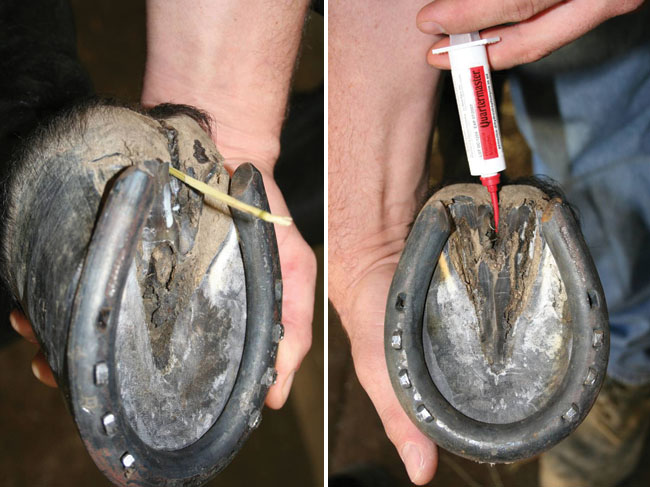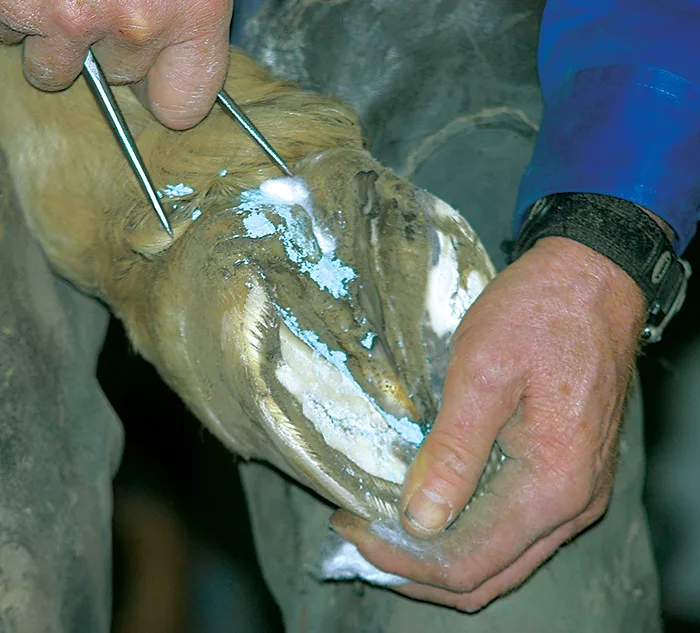Among the most common problems farriers deal with are thrush and white line disease. Thrush, affecting the sulci of the frog and sometime deeper tissues, is generally caused by bacteria. The most common culprit is fusobacterium necrophorum, which causes a variety of diseases, including navel ill/joint ill in foals, diphtheria in calves and foot rot in cattle.
White line disease (WLD) affects the middle and thickest layer of the hoof wall — the stratum medium — between the outer hoof wall and the insensitive laminae (also called the stratum internum). This disease is caused by keratin-digesting fungi, which enter the hoof through a separation in the hoof wall.
WLD generally starts at the bottom and eats its way upward, creating a separation of the hoof wall and hollow areas between the layers. There are several types of fungi that have been implicated. Treatment consists of opening the damaged area and trimming away all the diseased horn tissue, then treating with a product to kill the fungi.
A number of antiseptics and caustic products have been used over the years for treating thrush and/or WLD. Some are still in use and new products also have been developed.
Treatments For Thrush
Prevention is the best treatment for thrush. Keeping the horse in a dry, clean environment is best, but in some climates and circumstances, this is hard to do. It helps if the horse can be exercised regularly so feet can have proper blood circulation and also dry out — which won’t happen with horses standing all day in a stall or wet paddock. Flexing of the foot at each step, expanding and contracting as the animal travels, enables lodged material to fall out of the foot.
If a horse starts to develop thrush, treatment with iodine or a commercial thrush product will usually clear it up, especially if the horse is removed from dirty conditions. If the horse must be in a muddy paddock during wet seasons, daily care may be needed to correct and prevent thrush.
Hoof Hardeners May Help
Some horsemen and farriers use hoof hardeners such as Keratex Hoof Hardener or turpentine to dry up wet feet or help harden the soles, since soft, wet feet are usually more vulnerable to thrush. Keratex is a hoof disinfectant that contains tea tree oil, and other ingredients that tend to dry and dehydrate any bacteria or fungi. It can be applied twice a week to help prevent thrush.

Thrush attacks the insensitive layer of the frog, destroying the protection and shock-absorbing qualities of the frog. Thrush in the central sulcus will reduce the integrity of the hoof. Cleaning the affected area and treating daily with a broad-spectrum antibiotic used in the treatment of mastitis in non-lactating dairy animals can treat thrush.
There are other hoof sealers that help repel moisture, acid, manure and urine. These products tend to seal the outside of the foot and make it slicker, creating a more effective moisture barrier. Bruce Hague, a farrier in Vancouver, British Columbia, finds that Kopertox is often better for use on the bottom of the foot than Keratex or formaldehyde.
“If you use these on the foot, if there are any rotten areas in the frog or sole, those will tend to trap the pathogens in there. Before you use those products, you need to make sure the foot is very thoroughly cleaned so you don’t seal in any thrush organisms,” says Hague.
Care Needed With Drying Agents
Many hoof hardeners contain acetone or formaldehyde, which are drying agents, so you don’t want to overuse them.
Kopertox (which contains copper naphthenate) provides water resistant protection and is often used in treatment of thrush, but care should be taken to avoid spilling any on the horse’s hair because it burns the skin. Make sure it never gets in your eyes, and avoid breathing the vapors when applying it.
Many farriers, veterinarians and horse owners use ThrushBuster from Delta Mustad Hoofcare Center to prevent or treat thrush. Ingredients include isopropyl alcohol, an iodine complex and gentian violet dye. The latter provides color over the area you’ve treated. It only needs to be reapplied (about once a week, for mild cases) in areas where the color has faded. It is applied via a squirt bottle and is very easy to use.
ThrushBuster forms a clean barrier over the bottom of the foot to deter the penetration of contaminants from dirt and manure and is milder on the tissues than iodine, bleach or copper sulfate. Frequency of application will depend on severity of thrush.
Steve Norman, a Lexington, Ky., farrier, uses ThrushBuster for treating thrush and drying the foot up.
“That’s usually adequate, but in some cases I wrap the foot to keep out dirt and moisture while ThrushBuster is doing its job,” says Norman. “Keeping the foot clean is crucial, and drying up the infected frog to where you can cut out the dead material is also important.”
Whatever you use for treating thrush, apply it only to the affected areas. Many veterinarians and farriers prefer commercial products like ThrushBuster rather than iodine, since they are not as caustic if you should spill some.
“Iodine is more harsh and kills healthy tissue as well as bacteria,” says Norman. “You can’t use it consistently or you’ll overdo it. ThrushBuster is a little more appropriate for continual use. It not only kills the pathogens but also dries to form a barrier against re-infection.”
If thrush gets into the crevice at the center of the frog, that area will be very soft. Norman soaks a piece of cotton or gauze with ThrushBuster and sticks it down into the crevice to keep it open so it will dry out.
“As it dries, it will open the crevice even more, so you can carve out the dead tissue. Stuffing gauze in there to hold it open helps it dry better than just applying the ThrushBuster alone,” he says. “Within 14 to 30 days, all the dead tissue will peel out and there will be healthy tissue underneath.”
If a horse needs pads, extra care must be taken to prevent thrush, since a pad tends to hold moisture next to the foot. Mitch Taylor owner of the Kentucky Horseshoeing School in Mt. Eden, Ky., prefers to use Equi-Pak from Vettec to protect feet in these cases. Equi-Pak is a soft, instant pad material that’s squirted on with a gun and sets up within about a minute.
“This sticks to the frog and sole better than anything I’ve ever used and I just fill up the cavity of the foot. It seals the bottom of the foot and no moisture can get in there,” he says. “If you use a nail-on pad, you can squirt this between the pad and the foot to keep the moisture out and prevent thrush.”
Other Treatments
Some farriers use pour-pads with copper sulfate, which tends to retard thrush. Lewis Grant, a farrier in Langley, British Columbia, sometimes uses these, especially in horses with sheared heels or an out-of-balance foot.
“The horse may develop thrush because the foot is out of balance; the central sulcus of the frog may be broken open because the heels are sheared,” he says. “The best treatment for this — in conjunction with a bar shoe to tie the foot together and take the pressure off the heel that’s getting all the weight and stress — is to use a pour pad under the shoe, with copper sulfate in it.”
Equi-Pak CS is infused with copper sulfate and can be used on most cases of thrush. It takes 45 to 60 seconds longer to set than a regular pour pad, depending on climate and temperature. The sole and frog should be trimmed, cleaned and dried before applying the pour material.
Sole-Pak from Hawthorne and Magic Cushion from Premier Equine Health Products, are two medicated hoof-packing products that can be used in conjunction with pads for treating thrush.
Tia Nelson, a veterinarian and farrier in Helena, Mont., says her favorite treatment for thrush is household bleach.
“It’s cheap, effective and a strong oxidizer. Just don’t get any on the hairline,” she advises. “You don’t want it running along the crevice of the frog onto the heel bulbs or down the front of the hoof if you have the foot tipped up when applying it.”
Bleach will burn the skin and should be immediately rinsed off with lots of cold water if any is spilled on the skin. Be prepared to flush it off if you spill.
“I recommend applying the bleach with a paint brush. Some people use a small syringe so they can control the amount being applied,” says Nelson. “With a syringe you can squirt it just where you need it, and can aim it into the clefts and crevice of the frog.
“Bleach can be used straight, without dilution. Usually two applications will be enough to kill all the bacteria. If you clean and open up all the thrushy areas, sometimes that’s enough to resolve it, but I always use the bleach as well.
“It kills any pathogens that are there and also helps toughen the frog so it won’t be so vulnerable. I’ve seen feet so thrushy that when you use a hoof pick they bleed. The frog is soft and eaten up by the infection. Bleach helps toughen those areas,” says Nelson.
Worst Cases
In really bad cases that require more aggressive treatment, Steve Norman uses CleanTrax, a product that includes oxychlorosine as an active ingredient.
“This is a liquid you mix with water. You can soak the foot in a plastic bag and this product acts as a poultice,” he says. It tends to penetrate more deeply, to clear up a severe case, and draws out the infection — hopefully before it gets into the sensitive tissues.
CleanTrax comes in single-use bottles. These should be stored in a cool, dry place and not opened until use. The entire bottle should be poured into a gallon of lukewarm water and put into a soaking boot or bag, or a reinforced plastic bag. The foot should be soaked in this poultice for about 30 minutes (45 to 60 minutes for a severe infection). The solution will be active for about 90 minutes, so if you have several horses or feet to treat, you could use it for consecutive treatments by moving the solution to another foot.

White line disease starts at the base of the foot but can eat its way up through the hoof, creating a separation between the layers of the hoof. Here, it has eaten up into the hoof by more than the length of the hoof knife’s blade held by Leighton, Iowa, farrier Jeff Ridley.
Label information states that one bottle can also be used as a preventative treatment for thrush for one horse, by soaking each foot for about 20 minutes every 3 or 4 months. After soaking, the hoof should not be rinsed or dried.
Encasing the foot in an empty plastic bag and sealing the top around the foot, then leaving the foot encased for 30 to 60 more minutes, obtains the best results. This allows the vapors to penetrate the hoof.
A really bad case of thrush that invades the inner tissues of the foot must be treated like a puncture wound. The foot should be soaked daily in a warm saltwater solution for 20 to 30 minutes, after trimming away infected areas of the frog and opening them up for draining.
A warm water solution of Epsom salts can help pull infection out of the foot. Bandaging or use of a protective boot between soakings can help keep dirt and mud out of the open areas until the inner tissues have healed. The cleft of the frog can be packed with cotton soaked in disinfectant solution each time you re-bandage the foot.
Some veterinarians and farriers use a mild antibiotic cream for deep infections, applying it after the soaking. The mastitis medications (that come in a small syringe, to be infused into a cow’s teat) work well for this purpose; part of the contents from one of these tubes can be squirted into the affected area and then packed with cotton before bandaging.
Treating White Line Disease
The opportunistic pathogen that enters the hoof at the white line is a fungus. Mild cases can be completely trimmed away when the feet are trimmed for shoeing. But any cavity that can’t be trimmed completely away needs some kind of topical treatment to kill the fungus — after trimming away all the affected hoof horn.
One of the first fungicides recommended for treatment was Merthiolate, but it’s not used as much anymore because it contains mercury.
Other medications that have been reportedly used with success include povidone iodine, bleach (often diluted half-and-half with water), copper sulfate, formaldehyde, DMSO, pine tar, turpentine, gasoline and others, but some of these also have some drawbacks and disadvantages. Anti-fungal hoof repair materials are sometimes helpful.

Mike Pownall, a veterinarian and farrier from Rockwood, Ontario, says that medication is not as important as removing hoof wall from the affected area and opening it up to air. That is what was done in this case treated by Jeff Ridley, a farrier from Leighton, Iowa. Ridley combined this hoof-wall removal with a special shoe package.
Some people have good luck in early cases by treating with bleach. This can stop the fungus before it spreads, especially if applied daily for a month, then every few days until healthy new hoof horn has replaced the damaged horn.
Another option is gentian violet, which is found in products like ThrushBuster. Another product that seems to work well is called Hoof Disinfectant (made by Life Data). This is a topical disinfectant containing a tamed iodine solution. It’s delivered into the hoof capsule by the penetrating action of tea tree oil and readily kills bacteria and fungi.
According to Scott Morrison, a veterinarian and head of podiatry at Rood and Riddle Equine Hospital in Lexington, Ky., a study conducted by farrier Mike Wildenstein at Cornell University looked at various treatments and concluded the most effective products were those containing chlorine dioxide.
“The best way to deal with white line disease is to trim it out and then treat the surrounding tissue with a chlorine-dioxide foot soak or a topical gel that has chlorine dioxide in it,” says Morrison. “A mild case can also be killed with other products like copper sulfate. I don’t like using iodine inside the hoof wall because it tends to damage the proteins of the hoof horn.”
There are a wide number of products in use for white line disease, but according to Mike Pownall, the actual medication used is not nearly so important as removing the entire affected hoof wall and opening it up to the air. “Many of the medications don’t penetrate very well. Unless you remove some of the wall, the disease keeps on growing,” says Pownall, a veterinarian and farrier in Rockwood, Ontario.
Keep Your Tools Clean
The fungus can be transmitted from one horse to another on farrier’s tools, so he recommends disinfecting your tools between horses.
“There may be a high population of the fungus in an infected hoof, and if you work on another horse or nail a shoe to its foot, these pathogens could be spread by your tools,” says Pownall. “When I work on a horse with white line disease I usually wipe my tools with disinfectant afterward or heat them with a propane torch to kill any pathogens. Metal tools can be safely heated hot enough to kill the fungi.”
This article was originally published September 2009 and is updated regularly.
Related Content
Study Pinpoints Fungi as Cause, Confirms White Line Disease Treatment
We can now say with confidence that we have a safe and effective treatment method for white line disease, which is a fungal infection of a horse’s hoof.
Topical Treatments for White Line and Thrush
Everyone seems to have their favorite, but trimming, proper hoof care, seems to be the real key.
Tracking, Treating and Thwarting Thrush
To effectively treat thrush, the farrier sometimes needs to play detective to ferret out the root causes of the bacterial infection.








